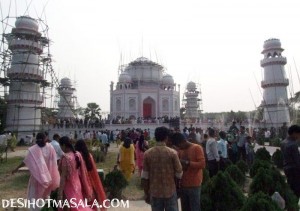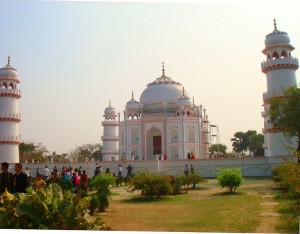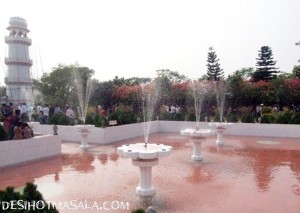When I was a child I disliked old persons. They repeated what they had said before a hundred times, and expected us to listen to them with rapt attention. Those days we had gramophones, and if the disc got worn out the ‘needle’ used to get stuck in a groove, and played the same line over and over until some one went and tapped the stylus manually.
It seems my needle has got into the “Taj Mahal” furrow and some one will have to give me a light tap to get out of it. I am hell bent on telling you all that I know about that monument in Agra. If you have had enough of it, just press the ‘delete’ key and move on with other mails; but please do not blame me for telling you things which you know already!
This time, we will skip all that crap about it being a ‘symbol of eternal love’ Now let us get to brass tacks, about the process of building the edifice and the structure. 
Before we get to it, let us remember that the construction of this monument began in 1633. At that time cement had not been invented and the term “re-enforced cement concrete” had not yet been coined. They had no vehicles, no cranes,and none of the earth moving machinery which we take for granted now. How then did they create this magnificent 167 foot high building? Here are a few startling ‘facts’:
Twenty thousand people worked on this for over 22 years to complete this project. More than one thousand elephants were deployed to carry the building materials. Since they had no cranes, a “ramp” was built to carry the stone up to the structure. The length and the height of the ramp kept increasing as the building progressed. At the end the ramp was EIGHTEEN kilometers long and high enough to reach the dome. The four minarets at the corners are not vertical. They lean outwards, so that if they ever fall, they will not damage the main building. No paint is used at all. The writing of the words from the Quran is through stone inlay in the marble. The size of the letters increases with the height; and so if you look at it from the floor, they appear to be of the same size. The stone for the building has come from Makrana and the precious stones are imported. The dome is designed such that the weight of the structure passes on to the walls on its own. That is in consonance with the Moghul architecture. The metallic finial on top of the dome weighs fourteen tons. However it has been replaced three times since the construction of the Taj. The building has withstood the vagaries of nature and wars for over 350 years without any major repairs. It now faces a new threat which comes from environmental pollution. I think it will weather that also. Now let us look at the economical side of the story. It has been estimated that the cost of construction in the seventeenth century was 3.2 crores. It is not possible to convert this figure to the present level of prices directly, but if we take the price of gold as an indicator, then it seems that the above figure translates to about 40,000 crores of rupees. (Gold was traded at Rs 1.4 per gram in 1635 and it now sells for over Rs 1800 per gram) However the cost of unskilled labor then was Rs 1.50 per month and that has now gone to about Rs 2,500 to 3500 per month in Agra. So if the Taj is constructed now with the same tools and equipment, it would perhaps cost about 20,000 crore. Even though these figures are not scary by the present standards, the cost of building the Taj was so heavy that the “Vazir-e-kharija” (the finance minister) threw his hands up, and said, “I can not give more” Shah Jehan was tried by his own sons and sentenced to life imprisoment for his ‘economic offence’ It is time to look at the ROI (returns on the investment) Poor old Shah Jehan did not build it as a profit center, but we have been gaining a lot from his ‘labor of love’ (The Emperor’s love and the labor of the workers) On an average, two to three million people visit the Taj annually. And this includes about 250,000 foreigners. The gate money itself runs into crores of rupees. Taj Mahal is the number one tourist destination in India. The exact figure is difficult to estimate, but over a million persons live out of the earnings created by the existence of the Taj. Take Taj out, and the economy of the city of Agra will collapse. 
Taj is not a shrine, nor a place of worship, yet people flock there. A majority of them know nothing of what is said above, but they go back and tell others, “Go see it” I have been to the Taj at least fifty times. It always looks the same, and yet it is different every time I go there. Recently, I asked myself, “What if some one builds a Taj Mahal now?” Lo and behold, I am told that a duplicate Taj Mahal has actually been built by a Bangladeshi film producer. He is known for creating ‘re-makes’ of Bollywood films. With the wealthe he amassed, he created a ‘pirated version of the Taj in his birthplace, near Dhaka. Some pictures of his creation is attached. Just as I had estimated, the total cost for building this copy of our Taj was $ 58 million (about Rs 275 crores in the Indian currency) It took him no more than five years to complete the project. He has received over a million visitors since then. When asked he said, “I have not built it for any person, living or dead. I love the people of Bangladesh, and I have built it for them!” The Indians were unhappy. They call it a case of plagiarism, infringement of a copyright.
And I ask, whose intellectual property has he stolen. Shah Jehan was the ruler of East Bengal as much as he was the monarch of what we now call India. and if for the people who can not reach Agra, he has built a ‘look alike’ of the Taj, so be it.
I personally think he has paid a tribute to the Taj. Because,
“IMITATION IS THE SINCEREST FORM OF FLATTERY”
On the Internet, I noticed a question, “Why do people flock to see the Taj Mahal?” The question is simple, and therefore, it must receive a simple answer. I would like to borrow an expression from Mr George Mellory, who die on his third attempt to climb the Everest. When asked why he wanted to go to the Everest, he said,
“BECAUSE IT IS THERE!”
 And people go to the Taj because it is there. A large majority of them know nothing of what I have said in my mails, but they go there to tell their friends, “I have seen the Taj Mahal”
And people go to the Taj because it is there. A large majority of them know nothing of what I have said in my mails, but they go there to tell their friends, “I have seen the Taj Mahal”
Now the last question. Will the visitors to the Taj decrease with the creation of the Bangladeshi Taj? the answer is a most emphatic NO. this imitation will only whet the appetite of the viewers to see the original. I think we should build at least four more ‘Taj Mahals’ My choice of locations is : Kanya Kumari in the south, a suburb of Mumbai in the west, Guwahati in the east and Chandigarh in the north. By my estimate, it will cost no more that Rs 100 crores (excluding land) if the building is made as a steel structure covered with vitreous tiles. the effect of precious stones can be created by LEDs
Please do not take my suggestion seriously. Actually, you should not take ANYTHING said by me seriously. In all honesty, I must tell you that I myself do not believe in much of what I say or write. As Somerset Maugham said,
“The only thing of which I am sure is that I am sure of nothing else”






I really loved your piece; I learnt so many things I never knew about the Taj. The view that it is hardly an eternal symbol of love is one that I have shared for a while, but well, it is glorious, simply on aesthetic and architectural grounds.
I have gotten in touch with both Sandeep and Aarti. I’ll probably be meeting Sandeep tomorrow (depending upon when he’s free) and I’ve already begun on a story for Aarti’s book.
As for what field of journalism I wish to enter, I’m really not sure yet. I love to write about food and travel, they both inspire adjectives after all. But I do feel that I have the potential to contribute a great deal to our country and I simply don’t see food or travel journalism as all that important. So, I’m mow debating over:-
1. Political Journalism: Where I study and become an expert on the machinations of government and then, am able to provide insightful commentary. (The con is that politicians rarely speak the truth and I might unwittingly end up being a mouthpiece for them)
2. Rural Journalism: To live among and understand the part of India that doesn’t live in the cities. Perhaps by writing about it, I can help improve their situation.
3. Defense Journalism: Already being an Army officer’s daughter gives me a fillip in this field. I must admit I have a romanticized notion of this though, writing about wars and bravery. But there are many stories there, to be told and I’m thinking I could tell them.
I need to fix upon one to specialize in before I go to Columbia, as you said.
I also need to finish my book, when it’s fresh in my mind. My novel is almost autobiographical, and deals with the quest for identity that my protagonist, a student at IIT Bombay, faces. I don’t wish to write in the Chetan Bhagat mould, this book is not about IIT. The college is simply the setting for a far more general feeling. What I’ve observed in my five years at college is, that we youth are very clueless about what we really want to do with our lives. In the absence of any set purpose, we drift, often into rather frightening territory.
I’ve made exhaustive notes on my characters and the incidents I want to relate, and have only just commenced writing. Perhaps I could send you some of my chapters as I finish them, for criticism? I could really use some mentoring, I’ve never done anything like this before.
I’m sorry for inflicting you with such a long mail, but I wanted to tell you what all I’ve been thinking about.
1.Good write up sir.fascinating too.
2. I say if one goes Via Agra (Viagra !) one may find the greatest erection by a man for a woman !
3. Shah Jehan had to have been suffering from a real and perpetual hard on problem. It is also called PRIAPISM in medical terminology.
4. The memorial is of course still erect and standing because firstly Shah jehan didn’t have to call for open global tenders and give contract to the lowest bidder and secondly MES was not a contender for the departmental works.
Your mails are interesting, as always. Of course they can not replace personal interactions with you which are even more enthralling,
Sometimes when music is good, one does not mind the gramophone needle stuck.
The British tried an imitation of the Taj and created the Victoria Memorial in Kolkata.
In the 19th century the East India Co toyed with the idea of selling the Taj for the marble, but better sense prevailed.
The Bangla Deshi Taj looks good but the proportions are different.
One of the amazing things about the Taj is the foundation — wooden piles, with arches above them. Once Dev Arora and his b-i-l, P Sharma, a journalist, came to Agra. The ASI people were willing to open the doors to the basement and foundation and show it to us. However, it was a holiday and they couldn’t get the keys. The wood has been treated with chemicals and has withstood 300 + years of wet surroundings.
Pollution is killing the Taj. Sulphur dioxide turns to sulphurous or sulphuric acid and has been eating away the marble. What was once smooth in 1963 is now pitted and rough
इक शहंशाह ने बना के हसीं ताज महल, हम ग़रीबों की मोहब्बत का उड़ाया है मजाक.
मेरी महबूब कहीं और मिला कर मुझसे.
__ साहिर लुधिआनवी